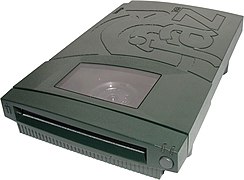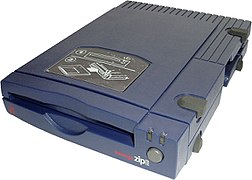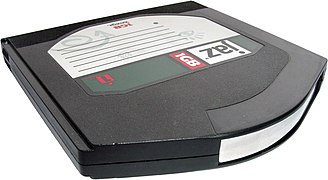Removable disk drive
Removable disk drives or removable hard disks are drives that are based on technology similar to floppy disk drives , but have a much higher performance, e.g. B. a higher speed or a higher capacity of the data carrier . The term “ removable disk” often refers to the storage medium that is inserted into the removable disk drive or the entire drive.
Historical meaning
Removable disk devices first appeared as fast peripheral mass storage devices on mainframes . The devices, the size of a washing machine and from the mid-1970s on a 19 "rack with a height of approx. 30 cm, had a capacity of a few megabytes at the beginning (1960s-70s) up to (around the end of the 1980s) several hundred megabytes to a few gigabytes per medium.
As an example, here is the data of the removable disk drive ISOT EC5066.M from the Unified System of Electronic Computing Technology (ESER), which represented the standard for mainframe components in the RGW:
| Manufacturer: | ISOT Bulgaria |
| Type: | EC5066.M |
| Storage medium: | Removable plate EC5266 |
| Storage capacity: | 100 Mb (weight of one medium: 13.5 kg) |
| Rotational speed: | 3600 rpm |
| Plate geometry: | 19 heads * 411 tracks * 512 bytes / sector * 26 sectors = 103953408 bytes |
| Connection of the ZVE via: | GSS EC5566 (large area control unit) with control module EC5666 |
| Number of spindles: | 1 |
| Data transfer rate: | 806 kbytes / s |
| average access time: | 30 ms |
| Number of plates / stack: | 12 (including 10 as data carriers and 2 protective plates) |
| Number of cylinders: | 404 (+7 reserve cylinders) |
| Number of Sectors: | 26th |
| Number of data areas: | 19th |
| Number of servo surfaces: | 1 (in the middle of the stack) |
| Recording method: | MFM |
| Construction year: | 1988 |
| Power consumption: | 12 A at 380 V three-phase current |
| Dimensions: | 320 kg |
With the sudden drop in prices for computing technology and electronic data carriers at the beginning of the 1990s, the end of this technology came for good. Except for a few copies, the drives were decommissioned by 1994 (presumably worldwide). Exceptions are museum specimens, devices in special scientific structures (ISOT CM5400 in a particle analyzer in an institute in Quedlinburg, scrapped in 2005) and devices from the high availability computer complex Neva 1M, a fully automatic switching system in the Russian Federation on the technological basis of the ESER EC1057, which was used until 2001 was in use and an availability of max. 1h failure / system has reached in 10 years.
Types and properties of modern removable disks
Removable disk drives are sometimes built into the computer , but most of them are portable. In this case they are usually connected to the computer via a USB , FireWire or SCSI connection, and in the past often also via the parallel port .
Important groups of removable disk drives are PD drives, magneto-optical drives ( MO ), the Jaz and Zip drives from the manufacturer iomega , and the SyJet or EZDrive drives from the SyQuest company .
The storage capacity of the data carriers is between 100 MB and several gigabytes, the speed between 0.2 and 2 MB / s. In terms of price, such drives are relatively cheap; However , they cannot match the speeds of modern hard drives .
Hard disk with and without removable frame
The possibility of converting a normal hard disk into a removable hard disk drive is often used in the server sector. For this purpose, a 3.5 ″ hard disk is usually installed in its own removable frame, in which it is screwed. This frame, in turn, can be plugged into a frame built into the computer (so-called interchangeable slot ) that takes up a 5.25 ″ slot and has an IDE , SATA, SCSI, SAS or USB 3.0 connection connected to the motherboard . Removable frames for hard disks for insertion in computer housings are usually made of plastic , sometimes also of metal , for example aluminum , for better dissipation of the heat given off by the hard disk during operation . The removable frame systems from the various manufacturers are generally not compatible with one another .
There are also systems that do not require a removable frame - the hard drives can then be plugged directly into the removable bay. These systems are often found in the private sector.
With this technology, high data transfer rates (as with any normal hard drive) and high storage capacity are on the list of advantages. One disadvantage is the size of the frame and the relatively high impact sensitivity of the hard disk. In the case of removable frames with IDE interfaces, functional impairments can occur if the removable frame is operated empty.
Since both the removable frame and the removable shaft hinder the heat transfer to the environment, the use of an additional fan above or below the removable frame or in the housing is recommended. Modern removable frame systems are equipped with both a fan and dampers, which have a vibration and noise-reducing effect.
SSD and optical drives
CompactFlash cards are often an alternative to other backup methods; They can be exchanged quickly using the slot bracket adapter on the rear of the case, as can hard drives, but they are more robust, but also more expensive (as of 2018). See also: Solid State Disks in Comparison and the following comments below.
Also, DVD-RAM and BD-RE drives are well used for backup, the media provided with respective file systems are initialized.
- Images of removable disk systems
Web links
- Museum at the FH-Merseburg (cooperation between SCI eV and digital AG Halle) ( Memento from January 21, 2014 in the Internet Archive ), information on GDR computing technology as well as photos and documentation on ESER and SKR






